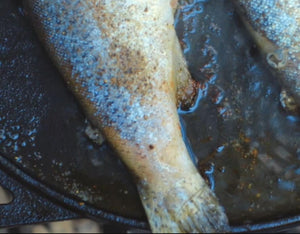How to Keep a Cast Iron Cookware Forever
Remember that no matter how damaged a cast iron pan may look, it can be made like new easily & quickly! Here are the solutions to 7 common problems you may encounter
Oxidation
Cause:
Oxidation forms when cookware is exposed to moisture for a long time and is not harmful in any way. If cast iron cookware is left in the sink to soak, placed in the dishwasher, or left to air dry, it will show surface oxidation. Avoid storing your cast iron cookware in damp environments, such as cabinets near a dishwasher, open cabinets in a damp location, or stored outside.
Solution:
Follow these three steps , to restore your cast iron:
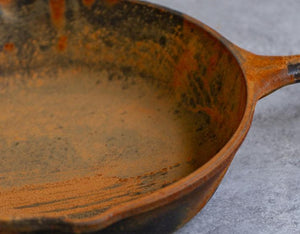
Step 1: Scrub
Abrade the affected surface using a wire scouring pad, warm water and soap. Since you will be re-seasoning your dish next, feel free to rub with all your might.
At this point it would be especially helpful to use Lodge's re-seasoning eraser, which is specially made to remove surface oxidation from cast iron surfaces with great ease! After use, carefully remove the residue and proceed with the recovery process described below.
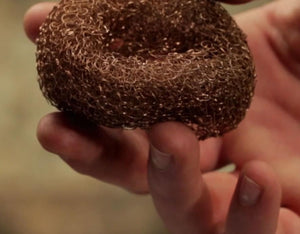
Step 2: Oil
Apply a very thin, even layer of cooking oil to the entire pan (inside and out). Caution! Do not use a large amount of oil, because the dish may become sticky.
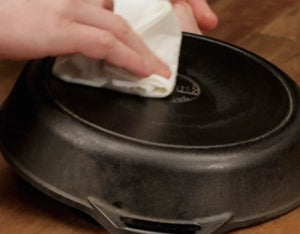
Step 3: Bake
Place the pan upside down on the top rack of the oven and aluminum foil on the bottom rack to catch excess oil in case it drips from the pan. Bake at 230-260 degrees C for one hour. Allow to cool and repeat if necessary to achieve the classic black patina look.
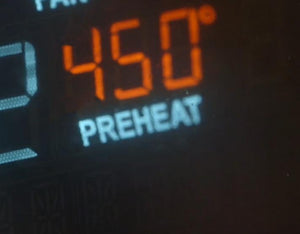
Sticks
Cause:
Sometimes food can stick to your cast iron cookware. This can happen for a number of reasons, such as not using enough fat or oil when cooking, using cookware that needs re-seasoning, or when using new cookware that has not developed additional non-stick layers.
Solution:
Before cooking, add about a teaspoon of oil to your pan and heat it gradually on the stovetop or in the oven to prevent sticking. After cooking, let the cookware cool down and then use a scraper to remove the stuck food, scrub with a cleaning brush or the special inox mesh sponge for cast iron surfaces. Dry by hand and add a generous coat of oil. Rub the oil into the pan until it is evenly distributed.

It peels off
Cause:
Occasionally, the natural non-stick coating (seasoning) on your pan can break and leave black spots.
Solution:
For remove any flakes, clean the pan lightly and then brush it with a thin layer of oil, placing it in the oven upside down on the top rack and baking for one hour at 230-260 degrees C. Place aluminum foil on the bottom rack to catch excess oil in case it drips from the pan. As the natural coating of the cast iron increases over time, the peeling will gradually stop occurring.
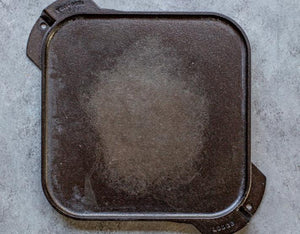
Sticky Food
Cause:
If you accidentally leave your cast iron cookware on any heat source for an extended period of time, food, marinades and sauces can burn and stick to the surface.
Solution:
Use a scraper to remove stuck-on food. If the problem persists, simmer some water in the pan for 3-5 minutes and then use the special scraper. Make sure to dry thoroughly and add a layer of oil afterwards. If this does not remove burnt food, follow the seasoning tips in the Oxidation section.
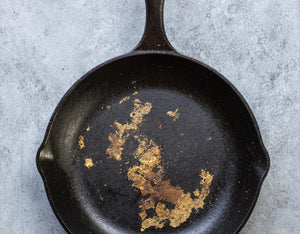
Black Remains
Cause:
There may be black residue from the natural non-stick coating (seasoning) of your cast iron cookware. They are not harmful at all and diminish as the utensil is used over time. They can appear when cooking liquids, boiling water, using soap on brand new cookware, or cooking acidic and alkaline foods such as beans and tomatoes.
Solution:
Continue to use and care properly your cast iron cookware and you will see a reduction in black residue as the natural seasoning which becomes even more intense with frequent use, tends to eliminate it.
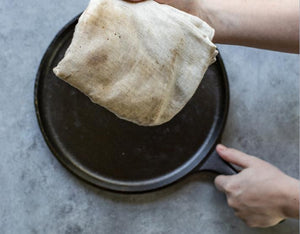
Sticky Surface
Cause:
If the 100% natural seasoning on your pan is sticky, this is a sign of excess oil that has accumulated on the cookware.
Solution:< /p>
To fix the sticky position, place the cookware upside down on the top rack of the oven and bake at 230-260 degrees C for one hour. Allow to cool and repeat the process if necessary.
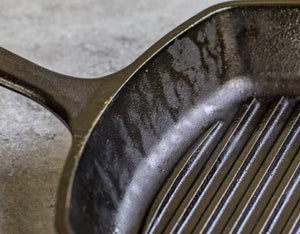
Odors
Cause:
When you cook fish or other spicy foods in cast iron cookware or clean them improperly and then store them, you may notice persistent odors on their surface.
Solution:
To eliminate unwanted smells, simply bake the cast iron pan in the oven at 204 degrees C for 15 minutes. This easy method allows you to get rid of persistent odors without damaging the 100% natural coating (seasoning) of your cast iron cookware. Another traditional method suggests sprinkling a layer of salt on the cooking surface of your cookware, leaving it overnight and washing it off in the morning, not neglecting to dry it directly and brush it with oil. If the odors still persist, you may need to clean with soap and follow the re-seasoning steps!
